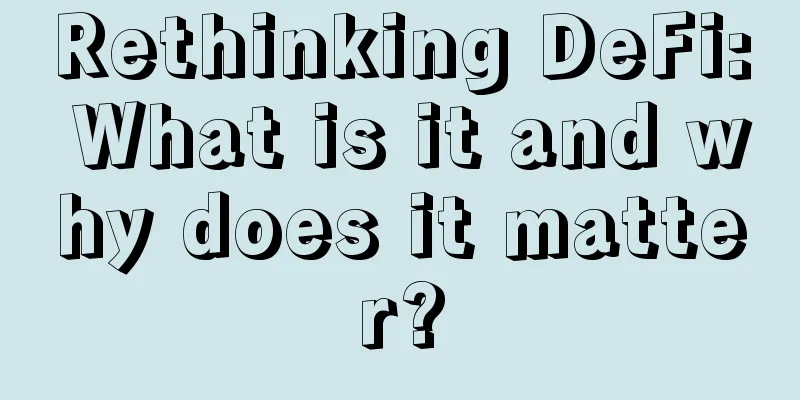Rethinking DeFi: What is it and why does it matter?

|
Written by: Marvin Ammori, Chief Legal Officer, Uniswap Labs There is a lot of hype, buzz, skepticism, confusion, and excitement about decentralized finance, or “DeFi.” DeFi is an ecosystem driven by blockchain-based products and services that replace traditional financial intermediaries with freely accessible, autonomous, and transparent software applications. While DeFi is still in its infancy (only a few years old), its associated economy is already very large and important: Ethereum, the backend infrastructure for DeFi, settled about $1.5 trillion in transactions last quarter, accounting for 50% of Visa's total payments; decentralized money markets (such as Compound, Aave, etc.) issue billions of dollars worth of loans every month; and individuals and businesses use platforms such as the Uniswap protocol to trade about 30% of Coinbase's volume. [Disclosure: I work at Uniswap Labs, the team that helped invent this protocol.] As this trend is of great interest to entrepreneurs, business leaders, policymakers, and institutions large and small, I will attempt to explain the characteristics of DeFi and the benefits it brings, outline some of the challenges ahead, and consider DeFi’s path to mainstream acceptance and adoption. But first, what makes this possible? What is DeFi? Where did it come from? DeFi builds on three major waves of blockchain innovation over the past decade, each of which began with deep skepticism and grew to acceptance and adoption. The first wave was defined by Bitcoin (invented in 2009), which gave us distributed ledgers (aka blockchains) designed to facilitate peer-to-peer transfers of non-sovereign digital assets. The second wave was defined by Ethereum, which is also rooted in the same underlying distributed, censorship-resistant architecture: however, unlike Bitcoin, Ethereum’s native programming language (Solidity) can be used to create any conceivable application, which in turn transforms Ethereum into a globally accessible supercomputer. The third wave was the Initial Coin Offering (ICO) boom of 2017, which funded a range of projects, some of which have begun to deliver on their promise to create a decentralized financial ecosystem. DeFi is the fourth wave, built on a combination of these innovations. Through DeFi, anyone in the world can use an easy-to-download wallet to borrow, send or trade blockchain-based assets without using a bank or broker. If they want, they can also explore more advanced (blockchain-based) financial activities such as leveraged trading, structured products, synthetic assets, insurance underwriting, market making, etc., while always maintaining full control of their assets. DeFi protocols adhere to key standards (particularly permissionlessness and transparency) that reflect the values of Ethereum, the open-source decentralized software platform that provides the infrastructure for most decentralized applications (dApps).
What are the characteristics and advantages of DeFi? DeFi’s two fundamental characteristics — permissionlessness and transparency — translate into multiple powerful use cases. Lower entry barriers, reduce switching costs, and provide optionality The permissionless nature of Ethereum-based applications enables the codebase of these applications to be freely and seamlessly "forked" (i.e. copied and adapted), reducing the barrier to entry for entrepreneurs to zero. End users are the main beneficiaries of this innovative environment: because all applications share the same database (the Ethereum blockchain), it is easy to move funds between platforms. This forces projects to compete ruthlessly on fees and user experience. A relevant example here is the rise of “exchange aggregator” applications: by using public APIs, these aggregators tap into multiple liquidity venues, splitting orders across platforms to provide the best possible exchange rate to the end user. In just a few months, these aggregators have accelerated DeFi’s progress toward best price execution, a standard that previously required formal regulation for early electronic trading venues. Contrast DeFi’s competitive market with existing personal banking, where it can take three days to open and close an account; or compare DeFi to brokerage, where transferring securities between platforms can take up to six business days and multiple calls. Coupled with other onerous terms, these “switching costs” discourage consumers from taking their business elsewhere, even with the pain of inferior service. In fact, to the detriment of individual consumers, traditional finance is moving in the exact opposite direction, with the number of banking licenses declining at an annual rate of 3.6% since 1990, limiting consumer choice. Transparent accounting and rigorous risk assessment The auditability of capital reserves in DeFi means that rigorous risk assessment and risk management can be achieved. For decentralized money markets and credit facilities (which allow users to obtain peer-to-peer, secured loans), users can check the quality of the collateral portfolio and the degree of leverage in the system at any given time. This is in stark contrast to the opaque nature of the current financial system. It was only after the global financial crisis of 2007-2008 that analysts and regulators began to appreciate that the US loan-to-deposit ratio had reached 3.5, twice that of the next most leveraged banking system, Russia. Coordinate incentive mechanisms to solve the principal-agent problem The use of trustless, programmable escrow accounts (commonly referred to as “smart contracts”) allows DeFi protocols to be secured at the protocol level. For example, in the MakerDAO system (a decentralized credit facility), MKR token holders earn interest paid by borrowers. However, in the event of (system) insolvency or (borrower) default, they will become the primary backstop: MKR will automatically be minted and sold to the market to cover losses (repay bad debts). This procedural enforcement creates very strict accountability, forcing MKR holders to set reasonable collateral and liquidation risk parameters, as lax risk management practices put MKR holders at risk of MKR dilution. In contrast, in traditional finance, when management makes mistakes, shareholders suffer direct losses. The recent bankruptcy of hedge fund Archego is a recent example: Credit Suisse lost about $4.7 billion due to its dealings with Archegos, causing heavy losses to the bank's investors, and although several of the bank's executives left the bank, they were not personally responsible for these losses. In DeFi, direct accountability will translate into better risk management. Modern infrastructure, improved market efficiency and robustness Ideally, in the Internet age, capital should flow as seamlessly as information. In particular, settlement should be instant, transaction costs should be minimal, and services should be available 24 hours a day, 7 days a week, and 365 days a year. Our global financial system only operates from 9 to 5 (except weekends and holidays), which is inefficient. There’s clear latent demand for a modern settlement infrastructure, as evidenced by the fact that Ethereum settled $1.5 trillion in trades last quarter, up from $31 billion in Q1 2019. We’ve also seen recently the potential for market disruptions due to a lack of instant settlement: online brokerage Robinhood was briefly forced to suspend buy orders for GameStop (GME) as it struggled to meet capital demands, itself a byproduct of T+2 settlement (an industry standard where trades typically take two days to clear). Effective markets also require robust infrastructure. The distributed nature of blockchains makes them incredibly resilient: in the six years since Ethereum launched, the network (and the applications built on it) have had 100% uptime. The same cannot be said for their centralized counterparts. Even in cases where they are centralized, established, and/or regulated, these centralized entities (whether exchanges or payment networks) can exhibit unreliability, especially during periods of high volatility. The impact on users is very real. Take the example of Robinhood’s sudden suspension of GME stock trading in March 2020, which caused some users to suffer losses and sue Robinhood for this. Global access, unified market In essence, international markets have larger liquidity pools that can significantly reduce transaction costs for all market participants. Today, decentralized exchanges (DEXs) can offer better exchange rates for certain assets than isolated centralized exchanges or service providers. In the stock market, financial instruments like American Depositary Receipts (ADRs) provide a bridge to the foreign exchange market, but often suffer from huge premiums and thin liquidity. When markets are accessible globally, it can also lead to more financial equity. Currently, some developing countries are often excluded from financial services due to the high cost of establishing local businesses relative to demand, lack of infrastructure, etc. But decentralized financial services can serve marginalized populations, providing services such as insurance, international payments, dollar-denominated savings accounts and credit. Real-time data One benefit of building financial services on a transparent shared database (i.e., the blockchain’s distributed ledger) is that all relevant transaction data is publicly available in real time. For example, in the Uniswap protocol, the returns generated by liquidity providers (LPs) can be tracked at a granularity of one second. Investors can use this data to decide how to allocate funds, thereby providing more efficient price discovery and resource allocation, while regulators can monitor real-time transaction data to identify illegal user activity. This is in stark contrast to traditional capital markets, where investors are kept in the dark until companies release their quarterly earnings reports. The situation is even worse in private markets, where companies often fudge their own bookkeeping metrics (if they decide to publish them at all). It’s hard to imagine investors making rational decisions when faced with out-of-date data! Regulators also struggle with the current system, where they may have to wait years to discover wrongdoing, often until it’s too late, with the collapse of Greensill Capital and Wirecard’s accounting fraud being just two recent case studies. Eliminate counterparty/credit risk and reduce compliance costs DeFi platforms are “self-custodial” by definition: users never place their assets in custody with a centralized operator. While DeFi may seem daunting to some at first, the self-custodial nature of DeFi helps eliminate counterparty and credit risk, which in traditional finance is associated with one party to a financial transaction defaulting or failing to fulfill its obligations on a transaction or loan. Analysts estimate that the total value of cryptocurrency lost through centralized exchanges (CEXs) since 2011 exceeds $7 billion, due to everything from hacker attacks to operators intentionally absconding with user funds. DeFi is a paradigm shift that transforms “don’t be evil” to “can’t be evil.” Self-custody is also beneficial to DeFi application operators, who can avoid unnecessary responsibilities and compliance management expenses: for example, cryptocurrency guidance issued by the US FinCen (Financial Crimes Enforcement Network) requires companies that custody user funds to obtain a money transmitter license, which is often a difficult process, while DeFi applications that interact with self-custodial wallets can operate without a license. Challenges of mainstream adoption As with any evolving new technology, DeFi faces challenges. This is not unlike the early days of the internet, when connections were slow, hardware was expensive, and even the smartest innovators were hampered by the inability to support images or videos, which are now widely used in online social activities. Scalability Ethereum, the underlying backend infrastructure of DeFi, must continue to scale to support higher bandwidth demands. Ethereum processes about 1.5 million independent transactions per day and has reached its maximum capacity, causing transaction fees to soar. However, expansion cannot come at the expense of security and decentralization. After years of intensive research and development, a variety of scalability solutions have been or will be launched soon, which are expected to reduce the burden on Ethereum while maintaining its core features. Need for better user experience For the average user, the DeFi onboarding experience is still overwhelming. The process of transferring fiat currencies (USD, EUR, GBP, etc.) to the crypto economy is still full of friction, fiat access is still limited to specific regions, and processing fees are too high. Even after fiat currency is converted into crypto assets, asset custody and wallet management can be daunting: specialized “wallets” must be installed to interact directly with the Ethereum network, and many wallets require users to protect highly sensitive passwords, private keys, and mnemonics, which have no recourse if lost. However, there is reason to be optimistic. The industry is moving towards best practices in custody and wallets: for example, the “smart wallet” Argent avoids seed phrases entirely and provides users with daily spending limits and seamless “social” recovery in the event of a lost device. I expect that over time, fiat on-ramps will become more competitive, with fees, coverage, and processing times improving as a result. A clear regulatory framework is needed Regulators around the world have a lot to deal with as technology disrupts new markets. In the financial sector alone, regulators are now dealing with everything from new banks and crowdfunding to gamified stock trading (such as the GameStop stock trading that went viral earlier this year). For years, blockchain technology was an area that was ignored by the traditional financial community, not to mention regulators. Now, regulators are evaluating the technology, the market, and the players to decide on appropriate rules. Their goals are to ensure adequate transparency for users and law enforcement; to target fraudulent activity (while discarding their previous assumption that all blockchain-based activity is fraudulent); and to protect consumer freedom and privacy. However, over the years, many policymakers and regulators have proposed regulatory approaches that could have stifled each previous wave of cryptocurrencies, even though it could have benefited consumers. Instead, they have focused on the negatives (such as Bitcoin being used to conduct illegal financing, high-risk investments through Ethereum and early token sales), often failing to recognize the larger positive aspects. As a result, there are regulatory proposals that misunderstand DeFi (both the roles of the different DeFi participants and the role of the technology) in a way that could impose responsibilities and burdens on innocent software developers far beyond existing law. These proposals are akin to trying to hold the inventor of SMTP responsible for every spam ever sent, or the inventor of HTTP responsible for every illegal website ever. Decentralized properties In much the same way that “private chains” are a product of misguided pursuits of earlier blockchain waves, it is possible that centralized financial institutions will borrow from the DeFi movement and make considerable concessions in the process. While they appear identical to other smart contract blockchains like Ethereum, some of these chains are in fact centralized, focused on providing users with higher network speeds and low fees, but at the expense of permissionless, neutral, and immutable blockchain properties that are core to the DeFi value proposition. While in every technological trend there are bound to be “weak” forms of technology that accompany their stronger counterparts, this is not an example of so-called weak forms of technology, but rather misleading marketing, like an old wolf in new sheep’s clothing. It is not difficult to imagine that some traditional financial institutions, such as commercial banks and large technology companies, do not study how to adopt or integrate DeFi, but adopt misleading or weaker versions. While these products may bring incremental benefits of efficiency, they cannot meet the full potential that this technology can provide: global, permissionless access to global liquidity, and the complete elimination of counterparty risk. DeFi is here to stay, and it’s here to stay. Some skeptics see it as an idealistic movement destined to remain forever in the shadow of the internet. But due to its innovations around settlement efficiency, risk management, and accessibility, DeFi is likely to become a core part of the financial infrastructure, not just for cryptocurrencies, but potentially for all other categories of markets: in the near future, people will be using DeFi protocols to sell tickets, Apple shares, pork futures, socks, and more, likely through portals that provide access to this infrastructure, with independent regulatory regimes and business activities. DeFi will not spell the end of the existing financial services industry as some die-hard believers may believe (just as the internet did not completely kill the printing press). However, the opportunity for DeFi for traditional financial services and other companies will be to allow them to focus on their core structural strengths — custody products, prime brokerage, fiat on-ramps, customer service, etc., while sourcing liquidity and products directly from decentralized protocols. Early skeptics said no one would use Bitcoin or think it had value; yet in just over a decade it has become a $1 trillion asset, comparable to gold, and held on the balance sheets of several public companies. Similarly, critics said Ethereum wouldn’t work, that it was too slow and too expensive; today, Ethereum powers thousands of permissionless applications, completes trillions of dollars in transactions, provides infrastructure for traditional financial giants, and contributes greatly to cutting-edge cryptographic research. Even if the ICO boom fails, many token sales have funded very important technological developments, including decentralized storage (a long-time holy grail in computing), network interoperability, manipulation-resistant data feeds, and decentralized computing. The bottom line is this: every crypto wave attracts thousands of engineers and entrepreneurs, and this is exactly how the DeFi future will be built. |
>>: Exploring the Horizon | DeFi Returns: The Road to ETH Layer 2
Recommend
What to look at in women's palmistry
Everyone has two hands, and everyone is intereste...
Does a man with a mole in his palace of official career have good career luck?
For men, power is still very important. Most wome...
If Bitcoin breaks through $300,000, will anyone in the market still sell it?
Dan Held, head of business growth at Kraken, rece...
Expert Says Bitcoin’s ‘Very Healthy’ Correction ‘Sets the Stage for More Steady Growth’
Bitcoin and the broader cryptocurrency market bou...
Physiognomy: Complete description of women's noses
In physiognomy , the nose is related to our fortu...
What do the dustpans on your fingers represent?
Fingerprints are actually a type of fingerprint t...
How to interpret the face of a person with horizontal lines on the bridge of the nose?
The bridge of the nose is located in the nose, wh...
What kind of women should not be married?
What kind of women should not be married? Fingers...
Is it true that a person with no hair on his lips cannot do anything?
As the saying goes: A man without a beard on his ...
What does it mean if there is only one dustpan for fingerprints?
Fingerprint prediction 1: basket, basket, basket,...
The circulation of Bitcoin has exceeded 18.5 million, and less than 2.5 million Bitcoins can be mined.
On September 28, according to ChartBTC’s Twitter ...
The 12th House of Physiognomy: The House of Brothers
The 12th House of Physiognomy: The House of Broth...
Do people with hanging needle lines between their eyebrows have a very rough life?
In fact, no matter whether your lines are congeni...
Don't marry a man with this kind of face or you will be abused.
In relationships, men with bad personalities are ...
What does a mole on a woman’s inner thigh mean?
Moles are not just melanin deposits, but also hav...









